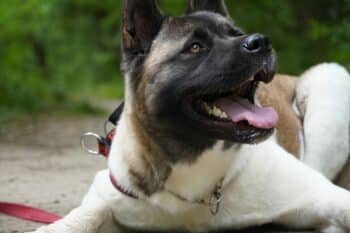Shutterstock
Dogs have been loyal companions to humans for thousands of years, but some breeds maintain a closer genetic and physical connection to their wild ancestors, the wolves. These breeds share similar physical traits, behaviors, and howling patterns with wolves, making them particularly fascinating to dog enthusiasts. Their wolf-like appearance and behaviors reflect a deep bond with their wild relatives, evident in their strength, endurance, independence, and pack mentality. These qualities make them unique and captivating, highlighting their primal connection to wolves.
Shikoku
Shutterstock
The Shikoku is a lesser-known breed from Japan that retains many wolf-like traits. Originally bred for hunting in the mountainous regions of Shikoku Island, these dogs are agile, resilient, and independent. Shikokus have a strong prey drive and a keen sense of adventure, which makes them resemble their wild ancestors. Their physical appearance, with a thick double coat, erect ears, and a curled tail, also contributes to their wolf-like aura. Shikokus are loyal and devoted to their families but require early socialization and training to manage their independence.
Samoyed
Shutterstock
Samoyeds are known for their striking appearance, with a thick, white double coat and a perpetual “smile.” These dogs were initially bred by the Samoyede people of Siberia for herding reindeer and pulling sleds. Their strong, muscular build and endurance are reminiscent of their wolf ancestors. Samoyeds are highly social and friendly, often forming strong bonds with their human families. Their vocal nature and howling tendencies also hint at their wolf-like origins. Despite their friendly demeanor, they retain a certain independence and resilience that makes them unique.
Akita Inu
Shutterstock
The Akita Inu is a large and powerful breed from Japan, initially used for hunting and guarding. They have a dignified and aloof demeanor, similar to wolves. Akitas possess a thick double coat, erect ears, and a curled tail, giving them a striking resemblance to their wild counterparts. Their loyalty and protective instincts are reminiscent of a wolf pack’s alpha. Akitas require firm and consistent training and socialization from a young age to channel their instincts into positive behaviors.
Alaskan Malamute
Shutterstock
Alaskan Malamutes are powerful, large dogs initially bred for strength and endurance, pulling heavy sleds in harsh Arctic conditions. Their physical strength, thick double coat, and facial markings closely resemble those of wolves. Malamutes are known for their friendly and affectionate nature, yet they possess an independent streak. They communicate through vocalizations, including howls, further aligning them with their wild ancestors. Malamutes thrive in environments where they can exercise and work, reflecting their heritage as working dogs.
Siberian Husky
Shutterstock
Siberian Huskies are medium-sized dogs known for strikingly resembling wolves, with their almond-shaped eyes, erect ears, and dense double coat. Bred by the Chukchi people of Siberia for sled pulling, Huskies are known for their stamina and endurance. They have a strong pack mentality and are known to howl rather than bark, similar to their wolf ancestors. Siberian Huskies are friendly and outgoing but also have an independent nature that requires firm training and socialization.
Saarloos Wolfdog
Shutterstock
The Saarloos Wolfdog is a breed developed by crossing German Shepherds with Eurasian wolves. This breed was created by Dutch breeder Leendert Saarloos to maintain a more wolf-like temperament and appearance. Saarloos Wolfdogs are large, with a strong, athletic build and a dense coat that comes in various wolf-like colors. They are known for being shy and reserved around strangers, often requiring careful socialization. While they are loyal and affectionate with their families, their independent and somewhat aloof demeanor makes them less suited to inexperienced owners.
Keeshond
Shutterstock
While smaller and less wolf-like in some respects, the Keeshond retains several traits reminiscent of their wild ancestors. They have a plush double coat, fox-like face, and expressive eyes, giving them a unique appearance. Keeshonds are known for their friendly and outgoing nature, making them excellent companions. They are highly social and enjoy being around people, often using their expressive faces to communicate. Despite their smaller size, Keeshonds have a thick coat and a lively personality, which can remind one of their distant wolf relatives.
Czechoslovakian Wolfdog
Shutterstock
Czechoslovakian Wolfdog is a breed that was developed by crossing German Shepherds with Carpathian wolves. This breed was originally created for military purposes but has become popular for its wolf-like appearance and versatile abilities. Czechoslovakian Wolfdogs have a strong build, erect ears, and a dense coat that resembles their wolf ancestors. They are highly intelligent and energetic and require significant exercise and mental stimulation. Their strong pack mentality and loyalty to their families make them excellent companions for experienced dog owners.
Greenland Dog
Shutterstock
Greenland Dog is an ancient breed used by the Inuit people for sledding and hunting. This breed strongly resembles wolves, with a thick double coat, erect ears, and a bushy tail. Greenland Dogs are known for their endurance, strength, and resilience in harsh Arctic conditions. They are loyal and hardworking, often forming strong bonds with their owners. Greenland Dogs are independent and can be somewhat reserved, requiring firm and consistent training. Their wolf-like appearance and hardworking nature make them excellent companions for those who lead an active lifestyle.
The Wild Side Of Man’s Best Friend
Shutterstock
These breeds resemble their wolf ancestors in appearance and behavior, sharing many traits that make them stand out among other dogs. Their physical strength, endurance, and sometimes independent nature contribute to their uniqueness as companions. While loyal and protective of their families, these breeds often require experienced handling and training to thrive in a domestic environment. Understanding their heritage and instincts is crucial for owners to provide the best care, ensuring a harmonious and fulfilling relationship with these remarkable dogs.
The post 9 Dog Breeds Closely Related To Wolves appeared first on iHeartDogs.com.

